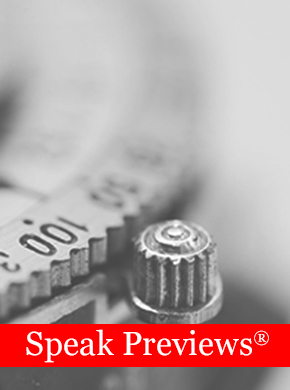I have a very long memory. I began my career as part of a communication subsidiary of a then well-known business-to-business advertising agency circa 1980, still the "dark ages" for presentation visuals.
Then and for some years to come, presentation graphics came in only a few forms. For large group presentations, glass-mounted 35 MM slides allowed for the use of beautiful photo-graphics in brilliant color. Overhead projectors used acetate slides or "foils" to present text and graphs. Flip charts or "easel pads" facilitated spur-of-the-moment additions or clarifications. The "black box" held a self-contained presentation featuring dazzling graphics. The cover slide appeared first; as the presenter moved forward, the viewed slide was shifted to the back platform, out of sight, and the next one was displayed.
Each of these had limitations: glass-mounted slides as well as black box visuals were costly. Overhead projectors invited text-heavy visuals, usually created on a typewriter with text too small to be easily legible. Flipcharts were bulky and often hard to handle; they were eventually considered passé, low-tech and old-fashioned.
And then came PowerPoint (in 2014 it celebrated its twenty-fifth anniversary). Iteration after iteration, it and similar programs have revolutionized the way textual and visual information is presented in every field.
Yet, for all the potential PowerPoint and similar programs have to support presentations with superior graphics and organization, most corporate presentations have adopted the negatives of the overhead projector: too much text per slide and font sizes too small to have impact. And, because PowerPoint slides can be created easily and cheaply, most speakers use far too many of them, making for a stilted, lecture-like presentation, allowing for little interaction between listener and presenter. In sum, there's often more "sit and listen" than communication going on.
Lately we've seen an uptick in the use of the oldest and simplest of these visual means of supporting presentations: the flipchart. While there may be some resistance within some corporate cultures to using a flipchart, feedback from clients with the courage to go a little low-tech has been positive in the extreme.
Its advantage is that it accommodates spontaneity—adding information, clarifying data, illustrating responses, providing listeners with the means to represent their comments visually. That which you create with your own hand in real time, versus something that pops up on a screen, has credibility, allows for greater engagement, greater and more meaningful interaction, and greater results for you and those you wish to influence. Additionally, it focuses audience attention on you and the words you speak as you write.
If you are required to provide updates on projects, initiatives, sales projections, are in sales, or frequently respond to audience members during Q&A, consider going back to the future by using a flipchart. You don't have to be a graphic artist to use it effectively, but here are a few tips that will help you:
- Do not use white board markers on paper (the color saturation is weak).
- Buy your own chisel tip markers, not pointed markers, designed for use on paper.
- When using chisel tip markers, hold them so that the broad side of the tip is doing the writing. It's a bit like bold-facing type.
- Practice your printing so that what you write is legible … and large.
- Don't hesitate to quickly draw graphs (showing trends, for example) or other visual depictions.
- Write, then speak. Or, speak, then write. You always want to talk to your listeners, not the flipchart.
If your office or meeting room has one, feel free to apply the flipchart techniques to a whiteboard. If you want to appear more tech savvy, invest in a tablet. I now travel with a Surface Pro 3 and use it in the same way I use a flipchart. The stylus allows for free-form writing and drawing. It is effective and facilitates interaction, leading to greater understanding and better results for both ECG and clients. Just like a flipchart.



